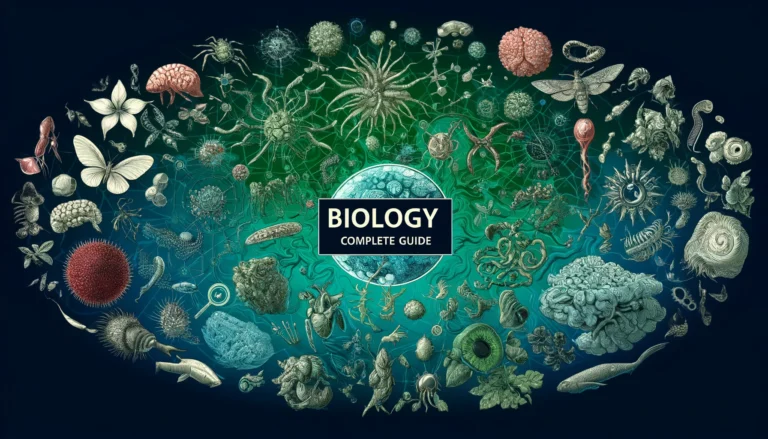What is Biology?
Biology is the branch of science that studies life and living organisms. This includes such subjects as the cell, genes, inheritance, microorganisms, plants, animals, and the human body.
There are many branches of science that are part of biology including ecology (how organisms interact with their environment), agriculture (the study of producing crops from the land), biochemistry (the chemical reactions needed to support life), botany (the study of plants), physiology (how living organisms function), and zoology (the study of animals).
Biology is the science of life. Its name is derived from the Greek words “bios” (life) and “logos” (study). Biologists study the structure, function, growth, origin, evolution and distribution of living organisms.
There are many branches of science that are part of biology including ecology (how organisms interact with their environment), agriculture (the study of producing crops from the land), biochemistry (the chemical reactions needed to support life), botany (the study of plants), physiology (how living organisms function), and zoology (the study of animals).
Fundamentals of Biology
Biology is based on some key theories and fundamentals:
The cell – The cell is the fundamental unit of all life. Every living organism is made up of one or more cells.
Genetics – Genetics is the study of how organisms pass on features and traits from generation to generation.
Homeostasis – Homeostasis is the process by which an organism or cell is able to regulate its conditions. For example, humans are able to regulate their body temperature to 98.6 degrees.
Energy – All living organisms are able to use external substances for energy. For example, humans use food such as vegetables and meat. Plants gather energy from the Sun through photosynthesis.
The word biology comes from the Greek words “bios” which means life and “logia” which means “study of”. Put those two words together and you get the “study of life.”
There are generally considered to be at least nine “umbrella” fields of biology, each of which consists of multiple subfields.
*Biochemistry: the study of the material substances that make up living things
*Botany: the study of plants, including agriculture
*Cellular biology: the study of the basic cellular units of living things
*Ecology: the study of how organisms interact with their environment
*Evolutionary biology: the study of the origins and changes in the diversity of life over time
*Genetics: the study of heredity
*Molecular biology: the study of biological molecules
*Physiology: the study of the functions of organisms and their parts
*Zoology: the study of animals, including animal behavior
Adding to the complexity of this enormous idea is the fact that these fields overlap. It is impossible to study zoology without knowing a great deal about evolution, physiology and ecology. You can’t study cellular biology without knowing biochemistry and molecular biology as well.
Framework of understanding
All the branches of biology can be unified within a framework of five basic understandings about living things. Studying the details of these five ideas provides the endless fascination of biological research:
*Cell Theory: There are three parts to cell theory — the cell is the basic unit of life, all living things are composed of cells, and all cells arise from pre-existing cells.
*Energy: All living things require energy, and energy flows between organisms and between organisms and the environment.
*Heredity: All living things have DNA and genetic information codes the structure and function of all cells.
*Equilibrium: All living things must maintain homeostasis, a state of balanced equilibrium between the organism and its environment.
*Evolution: This is the overall unifying concept of biology. Evolution is the change over time that is the engine of biological diversity.
Biology and other sciences
Biology is often studied in conjunction with other sciences, such as mathematics and engineering, and even social sciences. Here are a few examples:
●Biophysics involves matching patterns in life and analyzing them with physics and mathematics, according to the Biophysical Society.
●Astrobiology is the study the evolution of life in the universe, including the search for extraterrestrial life, according to NASA.
●Biogeography is the study of the distribution and evolution of life forms and the causes of the distribution, according to Dartmouth College.
●Biomathematics involves creating mathematical models to better understand patterns and phenomena within the biology world, according to North Carolina State University.
●Bioengineering is the application of engineering principles to biology principles and vice versa, according the University of California Berkeley.
●Sociologists often study how biology can shape social structures, cultures, and interactions, according to the American Sociological Association.
DOWNLOAD KVS SUPPORT MATERIAL CLASS X, XI & XII-2023-24
DOWNLOAD KVS SUPPORT MATERIAL CLASS X, XI & XII-2023-24
Study Material 2023-24-Class XII (KVS Ahmedabad RO) ![]()
Study Material and Question Bank Class X & XII -2023-24 (KVS Mumbai RO)![]()
Study Material Class XI -2023-24 (ZIET Chandigarh) ![]()
Study Material Class XII -2023-24 (ZIET Chandigarh) ![]()
Study Material Class X & XII -2023-24 (KVS RO RANCHI) ![]()
Study Material 2023-24-Class XII (ZIET-Mysuru) ![]()
Biology Class XI & XII CBSE Curriculum for the Academic Year 2023-24![]()
Bio Technology Class XI & XII CBSE Curriculum for the Academic Year 2023-24 ![]()
Biology Class XII CBSE Sample Question Paper 2023-24![]()
Biology Class XII CBSE Marking Scheme 2023-24![]()
CBSE Additional Practice Questions Biology Class XII 2023-24 ![]()
CLASS XII BIO WORKSHEET FOR SESSION (2023-24) KVS Ahmedabad RO![]()
BIOLOGY XII SUPPORT MATERIAL (2023-24)– KVS RO RANCHI ![]()
STUDY MATERIAL BIOLOGY CLASS XII 2023-24 ZIET CHANDIGARH ![]()
STUDY MATERIAL BIOLOGY CLASS XI 2023-24 ZIET CHANDIGARH ![]()
PRACTICAL BOOK BIOLOGY – CLASS-XI ![]()
CLASS XII BIOLOGY – COMPETENCY BASED QUESTIONS 2023-24 (ZIET CHANDIGARH)![]()
STUDY MATERIAL BIOLOGY CLASS-XII (KVS RO MUMBAI-2023-24)![]()
BIOLOGY STUDY MATERIAL CLASS-XII
- Biology Class-XII CBSE Sample Question Paper for Exam 2020-21
- Biology Class-XII CBSE Marking Scheme for Exam 2020-21
- STUDENT SUPPORT MATERIAL FOR CLASS XII 2020-21 (KVS Agra Region
- Biology Class-XII Question Bank– XII 2020-21 (KVS-Guwahati Region)
- Student Support Material for year 2019-20.
- Online Study Material Biology Class XII
- Quick Revision Notes Biology Class-XII
- Chapter wise StudyMaterial Biology XII
- Exemplar Solutions Biology Class -XII
- Biology XII –Concept Map
- Revised Syllabus of Biology (NCERT)
- Biology -XII Student Support Material 2019-20
- NCERT Solutions Biology XII
- Biology Class-XII Marking Scheme and Syllabus for Better preparation and Score Good Marks
- Sample Question Paper- Biology(CBSE for Exam 2019-20)
- Marking Scheme- Biology(CBSE for Exam 2019-20)
- Sample Question Paper- Biotechnology(CBSE for Exam 2019-20)
- Split up Biology-XI-XII 2019-20
- Split up Biotechnology-XI-XII 2019-20
- CBSE Sample Question Paper Class XII (2018-19)
- Biology Class-XII-Topic wise NCERT Solutions
- Student Support Material -XII
- Biology Question Bank Class-XII
- Graded Question Papers XII-Biology
- Exam Alert- Preparatory Test Series in Biology for Class XII
- Biology-XII- Chapter wise Diagram Based Questions
- Worksheet for Bright Learners
- Biology-XII Chapter Ending Test
- BIOLOGY(Question Bank)
BIOLOGY CBSE BOARD QUESTION PAPERS
SUPPORT MATERIAL – BIOLOGY CLASS-XII
1: Reproduction in Organism
2: Sexual Reproduction in Flowering Plants
3: Human Reproduction
4: Reproductive Health
5: Principles of Inheritance and Variations
BIOLOGY NOTES CLASS-XII
NEET MCQ QUESTIONS WITH ANSWER KEY (CLASS-XII)
BIOLOGY CLASS-XII (PPT)
NEET MCQ QUESTIONS WITH ANSWER KEY (CLASS-XI)
BIOLOGY STUDY MATERIAL CLASS-XI
Chapter wise MCQ
- The Living World
- Biological Classification
- Plant Kingdom
- Animal Kingdom
- Morphology of Flowering Plants
- Anatomy of Flowering Plants
- Structural Organisation in Animals
- Cell: The Unit of Life
- Biomolecules
- Cell Cycle and Cell Division
- Transport in Plants
- Mineral Nutrition
- Photosynthesis in Higher Plants
- Respiration in Plants
- Plant Growth and Development
- Digestion and Absorption
- Breathing and Exchange of Gases
- Body Fluids and Circulation
- Excretory Products and their Elimination
- Locomotion and Movement
- Neural Control and Coordination
- Chemical Coordination and Integration
BIOLOGY NOTES CLASS-XI
ASSIGNMENT- BIOLOGY CLASS-XI
- ASSIGNMENT 1 THE UNIT OF LIFE
- ASSIGNMENT 2 CELL CYCLE & CELL DIVISION
- ASSIGNMENT 3 TRANSPORT IN PLANTS
- ASSIGNMENT 4 MINERAL NUTRITION
- ASSIGNMENT 5 PHOTOSYNTHESIS IN HIGHER PLANTS
- ASSIGNMENT 6 RESPIRATION IN PLANTS
- ASSIGNMENT 7 ANATOMY IN FLOWERING PLANTS
- ASSIGNMENT 8 DIGESTION & ABSORPTION
- ASSIGNMENT 9 BREATHING & EXCHANGE OF GASES
- ASSIGNMENT 10 BLOOD FLUIDS AND CIRCULATION
- ASSIGNMENT 11 EXCRETORY PRODUCTS AND THEIR ELIMINATION
- ASSIGNMENT 12 CHEMICAL COORDINATION & INTEGRATION
- ASSIGNMENT 13 NEURAL CONTROL AND COORDINATION
- ASSIGNMENT 14 Locomotion and Movement
- ASSIGNMENT 16 Plant Kingdom
- ASSIGNMENT 17 Animal Kingdom
- ASSIGNMENT 18 MORPHOLOGY OF PLANTS
- ASSIGNMENT 19 ANATOMY OF FLOWERING PLANTS
- ASSIGNMENT 20 Structural Organisation in Animals
SOLVED SAMPLE PAPERS CLASS X 2019-20
BIOLOGY QUIZ
SCIENCE LABORATORY MANUALS (NCERT/CBSE)
THE PROGRAMME FOR INTERNATIONAL STUDENT ASSESSMENT (PISA)
- Introduction to PISA
- KVS Teachers Hand book Preparing Ground for PISA
- What are PISA and PISA for Development
- PISA – WHY, WHAT & HOW- AN OVERVIEW
- JOYFUL ACTIVITIES FOR PISA
- Download study material of PISA
PISA Handbooks for Teachers (CBSE)
CBSE along with an NGO, Central Square Foundation (CSF) , has launched two comics series for the students. Cotigo and The Question Book. This initiative will allow students to identify daily life problems and find ideal solutions themselves.
- Cogito (Explain what are critical thinking skills)
- The question book (Explain what are problem-solving skills)
CCT Practice Resources,Classes VII-X (CBSE)
COMPETITIVE EXAM
CAREER GUIDANCE
USEFUL LINKS FOR BIOLOGY
USEFUL LINKS
GENDER SENSITIZATION
BOOKLET ON CYBER SAFETY & SECURITY
USEFUL LINKS FOR SCIENCE
NCERT EBOOKS/MANUALS
- National Education Policy – 2020
- राष्ट्रीय शिक्षा नीति-2020
- NCF- 2005
- Sanitation and hygiene – Supplementary Material for the Upper Primary Stage
- Harit Shala ki Aur
- Towards a Green School
- Including Children with Special Needs – Primary Stage
- Education for Values in School-A Framework. Download Complete Book
- Basics in Education
- विज्ञान का शिक्षण
- Q & A Science and Mathematics in NCF-2005
- Meeting Special Needs in School: A Manual
- Teaching of Science
- Gender Issues in the Curriculum
- Aims of Education
- Teachers Resource for Achieving outcomes classes I to X (CBSE)
- School Kits and Lab Manual
- e-Resources – for Students
- e-Resources – for Teachers
BIOLOGY NEWS
- Lemur’s lament: When one vulnerable species stalks another
- Surf clams off the coast of Virginia reappear — and rebound
- New research defines specific genomic changes associated with the transmissibility of the monkeypox virus
- Why can zebrafish regenerate damaged heart tissue, while other fish species cannot?
- When thoughts flow in one direction
- Marine microbial populations: Potential sensors of the global change in the ocean
- RNA’s hidden potential: New study unveils its role in early life and future bioengineering
- Calorie restriction study reveals complexities in how diet impacts aging
- Honey bees experience multiple health stressors out-in-the-field
- Paleontologists unearth what may be the largest known marine reptile
DOWNLOAD
- Divisions of Algae and their Main Characteristics
- Division of kingdom fungi into various classes
- kingdom Protista
BIOLOGY OLYMPIAD
CBSE EBOOKS/MANUALS
- First Aid Practical Book
- First Aid and Emergency Medi Care
- Human Rights & Gender Studies
- Manuals, Handbooks, and Activity Calendar
- Skill Education
- Hubs of Learning
GENDER SENSITIVE PEDAGOGY
CONSTRUCTIVISM IN SCIENCE CLASS
REFERENCE
- Biology Dictionary
- Biology Dictionary (Meanings of biological terminology)
- Biology Online – Wiki Dictionary
- Biology Journals
- Biology Reference
- Encyclopaedia of Britannica
- Encyclopedia of Life (Global access to knowledge about life on Earth)
- Encyclopedia of Life Sciences
- Wikipedia (Biology)
- Wikibooks
- List of biologists
- Famous Indian Biologist
- Science References
- List of Biological Sciences Research Institutes in India
- Vigyan Prasar
E-LEARNING PLATFORMS
- NCERT YouTube Channel
- CBSE YouTube Channel
- IIT Pal (lectures on Physics)
- MHRD e-Content website
- National Digital Library of India
- NCERT Solutions
- NIOS YouTube Channel for Classes XI & XII
- MHRD YouTube Channel
- CSIR Jigyasa YouTube Channel
- NROER
- Khan Academy
- Google Classroom
KVS
- KVS Gyan Kosh
- KVS RO Ahmedabad
KVS RO Tinsukia - KVSROJabalpur
- ZIET Chandigarh Library Blog
- KVS Delhilive
- KVS RO Agra
- ZIET Mumbai
- KVS RO Lucknow
- KVS RO Jaipur
- KVSRO Guwahati
- KV1 Devlali Library Blog
- Easy Physics
Free DTH Channels
- DTH Channel No. 27 (Panini) (Secondary)
- DTH Channel No. 28 (Sharda) (Sr. Secondary)
Important Tips
Biology practical exam tips
Biology that deals with the study of the living world and living organisms wouldn’t be complete without practical classes. Whether you want to become a doctor or biotechnologist or simple ace your exams, remember to prepare for your Biology practical exams in addition to your preparation for Biology theory exams. Here are some tips
- Study the Biology theory that will form the basis of your experiments thoroughly
- The key to scoring high marks during a Biology practical exam is diagrams. Study from diagrams, revise from diagrams and practice drawing diagrams
- Spotting section can be scoring if you are familiar with the diagrams
- Knowing how to make correct sides is very important
- Understand the syllabus comprehensively so in each experiment/spotting you know what is to be done.
- Make a quick revision list for Biology practical preparation to revise the important points and concepts you need to know.
- Group study is helpful while preparing, each friend can describe an experiment while others try to identify the concept used in the experiment.
- Note down your experiment procedure carefully, many students lose marks. while writing the project notes in a hurry.
Although the Biology practical exam may seem easy, it’s important to devote some time to prepare, to help you score high in the overall Biology subject; theory and practical combined.
Branches of Biology
Following are the main branches of biology:
Anatomy – the study of organisms structures.
Comparative anatomy – the study of evolution of species through similarities and differences in their anatomy.
Histology – the study of tissues, a microscopic branch of anatomy.
Astrobiology (also known as exobiology, exopaleontology, and bioastronomy) – the study of evolution, distribution, and future of life in the universe.
Biochemistry – the study of the chemical reactions required for life to exist and function, usually a focus on the cellular level.
Biological engineering – the attempt to create products inspired by biological systems or to modify and interact with the biological systems.
Biogeography – the study of the distribution of species spatially and temporally.
Bioinformatics – the use of information technology for the study, collection, and storage of genomic and other biological data.
Biolinguistics – the study of the biology and evolution of language.
Biomechanics – the study of the mechanics of living beings.
Biomedical research – the study of health and disease.
Biophysics – the study of biological processes by applying the theories and methods traditionally employed in the physical sciences.
Biotechnology – the study of the manipulation of living matter, including genetic modification and synthetic biology.
Synthetic biology – research integrating biology and engineering; construction of biological functions not found in nature.
Botany – the study of plants
Phycology – scientific study of algae.
Plant physiology – concerned with the functioning, or physiology, of plants.
Cell biology – the study of the cell as a complete unit, and the molecular and chemical interactions that occur within a living cell.
Chronobiology – the study of periodic events in living systems.
Cognitive biology – the study of cognition.
Conservation biology – the study of the preservation, protection, or restoration of the natural environment, natural ecosystems, vegetation, and wildlife.
Cryobiology – the study of the effects of lower than normally preferred temperatures on living beings.
Developmental biology – the study of the processes through which an organism forms, from zygote to full structure.
Embryology – the study of the development of embryo (from fecundation to birth)
Gerontology – study of ageing processes.
Ecology – the study of the interactions of living organisms with one another and with the non-living elements of their environment.
Evolutionary biology – the study of the origin and descent of species over time.
Genetics – the study of genes and heredity.
Genomics – the study of genomes.
Epigenetics – the study of heritable changes in gene expression or cellular phenotype caused by mechanisms other than changes in the underlying DNA sequence.
Immunology – the study of the immune system.
Marine biology (or biological oceanography) – the study of ocean ecosystems, plants, animals, and other living beings.
Microbiology – the study of microscopic organisms (microorganisms) and their interactions with other living things.
Bacteriology – the study of bacteria.
Mycology – the study of fungi.
Parasitology – the study of parasites and parasitism.
Virology – the study of viruses and some other virus-like agents.
Molecular biology – the study of biology and biological functions at the molecular level, some cross over with biochemistry.
Nanobiology – the application of nanotechnology in biological research, and the study of living organisms and parts on the nanoscale level of organization.
Neuroscience – the study of the nervous system.
Paleontology – the study of fossils and sometimes geographic evidence of prehistoric life.
Pathobiology or pathology – the study of diseases, and the causes, processes, nature, and development of disease.
Pharmacology – the study of the interactions between drugs and organisms.
Physiology – the study of the functions and mechanisms occurring in living organisms.
Phytopathology – the study of plant diseases (also called Plant Pathology).
Psychobiology – the application of methods traditionally used in biology to study human and non-human animals behaviour.
Quantum biology – the study of the role of quantum phenomena in biological processes.
Systems biology – the study complex interactions within biological systems through a holistic approach.
Structural biology – a branch of molecular biology, biochemistry, and biophysicsconcerned with the molecular structure of biological macromolecules.
Theoretical biology – the branch of biology that employs abstractions and mathematical models to explain biological phenomena.
Zoology – the study of animals, including classification, physiology, development, evolution and behaviour, including:
1. Ethology – the study of animal behaviour.
2. Entomology – the study of insects.
3. Herpetology – the study of reptiles and amphibians.
4. Ichthyology – the study of fish.
5. Mammalogy – the study of mammals.
6. Ornithology – the study of birds.
Digital Resources for Science Teachers
101 Science is a site with a huge amount of resources for science, organized by topics such as “electronics”, “chemistry”, “biology”, “physics”, “math” and “photography”, there are also resources for earth science, astronomy, robotics, ethics, java applets, and much more. Each category has scores of links and resources, including articles, web sites, and videos. Some videos are from MIT, TED and more.
Chemical Education Digital Library is a large collection of resources for teaching and learning chemistry, including tutorials for students, 3D models, lesson plans, and more. The tutorials include 3D chemical models and explanations of what each part of the models does and how those parts work together. There is a periodic table that links each element to data and explanations about that element.
LearnChemistry Provides learning and teaching resources all about Chemistry, videos, interactive periodic table, chemistry teachers community, continual professional development, an online community for young chemists to chat and explore. It’s from the RSC — the largest organisation in Europe for advancing the chemical sciences.
The Periodic Table of Videos (by University of Nottingham) is a periodic table in which each element is linked to a short movie about the element.
Intel STEM Resources is to help educators inspire the next generation of innovators with Science, Technology, Engineering and Mathematics (STEM) learning, Intel provides curriculum and online resources to encourage students’ interest and participation.
The Physics Classroom is an online physics tutorial written for high school physics students
The National Science Digital Library is the nation’s online library for education and research in science, technology, engineering, and mathematics. It provides free math lessons and activities aligned with the Math Common Core Standards, as well as STEM-related blogs and other free teacher resources and lesson plan ideas. Targeted for K-12 teachers, higher-education professionals, and librarians, NSDL also provides science literary maps and iTunes multimedia files.
National Science Resources Center is provided by the Smithsonian Institution and the National Academies to improve the learning and teaching of science for all students throughout the world.
Science Netlinks is an Internet-based free learning activities, tools, reviewed websites to support K-12 standards-based teaching and learning.
Affiliated Organization: American Association for the Advancement of Science.
NOAA (NOAA Educational Ocean Service) joins hundreds of organizations and agencies in a celebration of science to make science more accessible, personally meaningful, and locally relevant. Be sure to check their lesson plan library. Students will be thrilled to engage in activities and games in the Planet Arcade .
Science Education Resource Center is an office of Carleton College, works to improve education through projects that support educators. The office has special expertise in effective pedagogies, geoscience education, community organization, workshop leadership, digital libraries, website development and program and website evaluation.
National Geographic has been inspiring people to care about the planet since 1888, the education resources and games are the sites teachers and parents must visit. There is an education channel full of resources for teaching, programs, multimedia and mapmaker for you to customize your own map.
Discovery Education is also a massive site full of free lesson plans, featured contents in many fields, not only science. Home resources and teacher professional development are also included.
NASA for Educators includes featured articles with information about NASA’s various missions; image galleries on a wide variety of topics; information about NASA careers, internships, fellowships, and scholarships; NASA-produced multimedia materials; and more. Users can search resources by keyword, grade level, and subject.
The Computational Science Education Reference Desk (CSERD) is a Pathways portal of the National Science Digital Library and funded by the National Science Foundation. CSERD aims to help students learn about computational science and to help faculty and teachers incorporate it into the classroom.
PlantingScience makes science experts accessible to secondary school classrooms with the goal of improving understanding of science while fostering an awareness of plants. Plant biology research projects and student dialogue with online mentors about the student-generated research are part of the online learning community.
Ask A Biologist – An educational Web site adds new twists to learning by promoting direct conversations between scientists and the public.
Beyond Penguins and Polar Bears consists of 20 thematic issues relating elementary science concepts to the real-world context of the polar regions. The online magazine format provides professional development content and instructional resources with a focus on integrating science and literacy. It’s for elementary schoolers.
Understanding Evolution is a site providing educational materials targeting teachers of kindergarten through college, students, and the general public, the one-stop source for information on evolution has resources engage students with data, explore scientific reasoning and science as a human endeavor, and demonstrate the relevance of evolution to everyday life.
Benefits of Olympiad Examination
Appearing for an Olympiad is beyond school.Olympiad exams are competitive examination conducted at school level. It is totally based on the school curriculum and is conducted by various independent organizations.These competitive exams aim to provide exposure to students and make them ready to face any challenge in future.
Olympiad exams are considered as a burden by many students. They take it as an addition to their routine studies. Parents believe that appearing for Olympiad exams hamper their child’s academic grades. As it is said, every coin has two sides; such is the case here also. It is advisable to consider Olympiad bliss rather than havoc.
Olympiads are highly challenging as it improves your aptitude and competitive spirit among students. Here are a few perspectives that we would like to share with you:
1.Future talent pool: Olympiad exams help to identify young geniuses. It brings out the best in students. There are various exams conducted on various subjects like Science, Mathematics, English, General Knowledge and Computers that help students to solve complex problems in no time. It is not just an exam; its objective is to provide a competitive platform to students, thus creating a talent pool for future.
2.Provides a big platform: Olympiads, as conducted by various foundations like the Science Olympiad Foundation, National Olympiad foundation, etc. provide a big platform where even primary level students can showcase their talent at state, national and international levels.
3.Build confidence in the student: Olympiads motivate students to aspire and strive for better and emerge out to be the best. A student holding a rank in an Olympiad develops a sense of confidence.
4.Improvement in class results: Olympiad exam helps in improving student routine class result. Olympiads improve their conceptual understanding and enables students to grasp tricky concepts.
5.Gain additional knowledge: Olympiad exam gives a chance to students to sharpen their skills. They tackle a number of problems at a level they are not likely to encounter in their classrooms. Students gain additional knowledge and get an early exposure to competition and learning. They learn to confidently write answers. These competitions sharpen the minds of the youth.
6.Improves reasoning ability:These exams help students to cultivate analytical thinking which is useful in any examination. Olympiads not only improve the logical thinking and help in brainstorming but also enhance the analytical and reasoning ability, problem-solving skills, and confidence. Overall, it helps in the development of a child at a young stage.
Above all, participating in Olympiad exams and representing one’s state or country at national and international level gives the satisfaction and pleasure to the students which itself is the best reward for them.
First Aid-10 Things You Must Have In Your First Aid Box
Administering the right first aid to a victim can make all the difference in the world. Not only can it assure a speedy recovery, but at times it can make a life-threatening situation more manageable. Having a well-equipped first-aid box at home is very important, especially when you have kids and pets in the house. In an emergency, it is the contents of this box that will come to your aid while you suffer through a long drive to the hospital or wait for the ambulance to come to your front door.Your first-aid box must have the ultimate solution for common ailments. Whether you have a headache, an allergic reaction, a broken toenail or have suffered a few burns, it is these items in your first aid box that will provide instant relief. However, don’t just stock it and forget about it. You must remember to clean and re-stock your medicines and creams time and again. Do look at the expiry dates and throw out items that have lived their life. In an emergency, nothing can be worse than having an expired medicine or tube of gel in your first aid box.Top 10 things that must be included in your home first aid box:
1. Adhesive Bandages : It is never a good idea to leave cuts and scrapes uncovered. So go ahead and buy a few adhesive bandages since they come in all colours, sizes and shapes.You might want to pick the larger ones for bigger cuts, and smaller ones for shaving cuts and smaller scrapes. Also, find colourful ones that your kid will want to wear proudly instead of ripping off. Also, talk to your vet if you have pets and get bandages meant for dogs or cats (whatever the case may be).
2. Antiseptic Creams And Lotions : Before you put on that bandage, you will need to thoroughly clean a wound. While soap and water work fine, it is advisable to use a good antiseptic lotion to thoroughly rinse out any debris or particles in the wound that could infect it. Also, if the wound is large and could get pus formation, you will need to use an antiseptic regularly while you dress up the wound. So buy Dettol or Savlon to kill all germs and bacteria that can thrive in an open wound.
3. Muscle Creams And Sprays : Having a sprain or a backache is one of the most common ailments people complain of, second only to headaches. To ensure that your aching muscles get instant relief, do stock up on muscle creams and gels. A spray is a more effective option, especially when you want to couple it with a heating pad.However, you should use them in moderation as the ingredients do get absorbed directly in to your bloodstream through the skin.
4. A Pair Of Tweezers : A fine-tipped pair of tweezers can come in handy in so many ways. Remove foreign objects lodged in the skin like splinters. Or easily remove your dog’sticks using them. Make sure you sterilise the tweezers by cleaning them with an antiseptic lotion.
5. Sterile Gauze And Tape : For bigger injuries, especially those that are bleeding profusely, you will need sterile gauze and medical tape to create a larger bandage. Where a band-aid seems to be too small to cover the wound, use these two. Create padding with sterile gauze, apply a little antiseptic cream, and cover the wound. Then secure in place with the tape. These also work especially well on kids and pets since they cannot remove this as easily.
6. Pain Relievers : What’s more common than a headache or backache? Having a few pain relievers like Crocin and Combiflam in your first-aid box is a must. Even if the pain is persistent and needs to be checked by a doctor, you can still pop a painkiller to help you bear with the trip down to the clinic and the long wait before you get the turn to meet with your doctor. If you have kids, keep some mild pain relievers at hand. And if you have pets, make sure you talk to your vet about the best painkiller for dogs and cats. Remember, while most human medicines work on dogs, some of them can be poisonous to their system.
7. Antihistamines : With all the changing weather and increased pollution, which household doesn’t have people who develop allergic reactions easily? From sneezing to breaking out in a rash, antihistamine will take care of all allergies. While sinus and dust allergies might not need medical attention, a food allergy might need a trip to the doctor. In any case, the allergy medication will provide a little relief while you rush the patient to the emergency.
8. Fungal Medicines : If you live in a hot, humid climate for any part of the year, you’ll be well aware of the risk of fungal infections. These infections can erupt anytime, anywhere.From your genitals to your feet, your face and hands, these fungal infections can be itchy and embarrassing. So make sure you have an anti-fungal cream at home to provide relief from the persistent itch. You can get these in the form of gels, creams, powders and even pills.
9. Nail Clippers : Yes, these also find themselves on the list of top 10 things to keep in a first-aid box. You may think that cutting your nails and shaping them can pose no emergency, but what about a painful ingrown toenail? And not to mention painful hangnails that can actually get infected if chewed on or ripped out. So make sure you have nail clippers in your first-aid box to clip nails and hangnails and keep the nails clean. You might not realise this but dirty nails are the biggest cause for fungal infections, bacterial growths and warts.
10. Thermometer And Fever Medication : Any first-aid box is incomplete without a good thermometer. And make sure you buy the right kind. No longer do doctors recommend a mercury thermometer. Get yourself a digital thermometer, and if you have kids and pets, we recommend you get an ear-canal thermometer. Fevers are common, so do keep Crocin or basic paracetamol to ensure that you can regulate normal body temperature while your doctor diagnoses the cause. He may further recommend antibiotics or other medication, but popping an antipathetic will help you while you wait for the diagnosis.
Here are the top 10 things to keep stocked in your first-aid box. Go ahead and pick a good-sized box to create your very own first-aid kit or buy a ready made one and start storing away these things for uncalled emergencies.
Click following video
AP Biology Past Exam
2023: Free-Response Questions
| Questions | Scoring | Samples and Commentary |
|---|---|---|
|
2022: Free-Response Questions
2022: Free-Response Questions
Questions | Scoring | Samples and Commentary |
|---|---|---|
|
2021 Free-Response Questions
2021: Free-Response Questions
Questions | Scoring | Samples and Commentary |
|---|---|---|
2020 Free-Response Questions
2020: Free-Response Questions
The 2020 free-response questions are available in the AP Classroom question bank.
2019 Free-Response Questions
2019: Free-Response Questions
Questions | Scoring | Samples and Commentary |
|---|---|---|
2018 Free-Response Questions
2018: Free-Response Questions
Questions | Scoring | Samples and Commentary |
|---|---|---|
2017 Free-Response Questions
2017: Free-Response Questions
Questions | Scoring | Samples and Commentary |
|---|---|---|
2016 Free-Response Questions
2016: Free-Response Questions
Questions | Scoring | Samples and Commentary |
|---|---|---|
2015 Free-Response Questions
2015: Free-Response Questions
Questions | Scoring | Samples and Commentary |
|---|---|---|
2014 Free-Response Questions
2014: Free-Response Questions
Questions | Scoring | Samples and Commentary |
|---|---|---|
2013 Free-Response Questions
2013: Free-Response Questions
Questions | Scoring | Samples and Commentary |
|---|---|---|
2012 Free-Response Questions
2012: Free-Response Questions
Questions | Scoring | Samples and Commentary |
|---|---|---|
Sample Responses Q1 |
2011 Free-Response Questions
2011: Free-Response Questions
Questions | Scoring | Samples and Commentary |
|---|---|---|
Sample Responses Q1 |
2011 Form B
2011: Form B
Questions | Scoring | Samples and Commentary |
|---|---|---|
Sample Responses Q1 |
2010 Free-Response Questions
2010: Free-Response Questions
Questions | Scoring | Samples and Commentary |
|---|---|---|
Sample Responses Q1 |
2010 Form B
2010: Form B
Questions | Scoring | Samples and Commentary |
|---|---|---|
Sample Responses Q1 |
2009 Free-Response Questions
2009: Free-Response Questions
Questions | Scoring | Samples and Commentary |
|---|---|---|
Sample Responses Q1 |
2009 Form B
2009: Form B
Questions | Scoring | Samples and Commentary |
|---|---|---|
Sample Responses Q1 |
2008 Free-Response Questions
2008: Free-Response Questions
Questions | Scoring | Samples and Commentary |
|---|---|---|
Sample Responses Q1 |
2008 Form B
2008: Form B
Questions | Scoring | Samples and Commentary |
|---|---|---|
Sample Responses Q1 |
2007 Free-Response Questions
2007: Free-Response Questions
Questions | Scoring | Samples and Commentary |
|---|---|---|
Sample Responses Q1 |
2007 Form B
2007: Form B
Questions | Scoring | Samples and Commentary |
|---|---|---|
Sample Responses Q1 |
2006 Free-Response Questions
2006: Free-Response Questions
Questions | Scoring | Samples and Commentary |
|---|---|---|
Sample Responses Q1 |
2006 Form B
2006: Form B
Questions | Scoring | Samples and Commentary |
|---|---|---|
Sample Responses Q1 |
2005 Free-Response Questions
2005: Free-Response Questions
Questions | Scoring | Samples |
|---|---|---|
Scoring Guidelines |
2005 Form B
2005: Form B
Questions | Scoring | Samples |
|---|---|---|
2004 Free-Response Questions
2004: Free-Response Questions
Questions | Scoring | Samples |
|---|---|---|
Scoring Guidelines | Sample Responses Q1 |
2004 Form B
2004: Form B
Questions | Scoring | Samples |
|---|---|---|
Sample Responses Q1 |
2003 Free-Response Questions
2003: Free-Response Questions
Questions | Scoring | Samples |
|---|---|---|
Sample Responses Q1 |
2003 Form B
2003: Part B
Questions | Scoring | Samples |
|---|---|---|
Sample Responses Q1 |
2002 Free-Response Questions
2002: Free-Response Questions
Questions | Scoring | Samples |
|---|---|---|
2002 Form B
2002: Form B
| Questions | Scoring | Samples |
|---|---|---|
2001 Free-Response Questions
2001: Free-Response Questions
Questions | Scoring | Samples |
|---|---|---|
2000 Free-Response Questions
2000: Free-Response Questions
Questions | Scoring | Samples |
|---|---|---|
1999 Free-Response Questions
1999: Free-Response Questions
Questions | Scoring | Samples |
|---|---|---|








